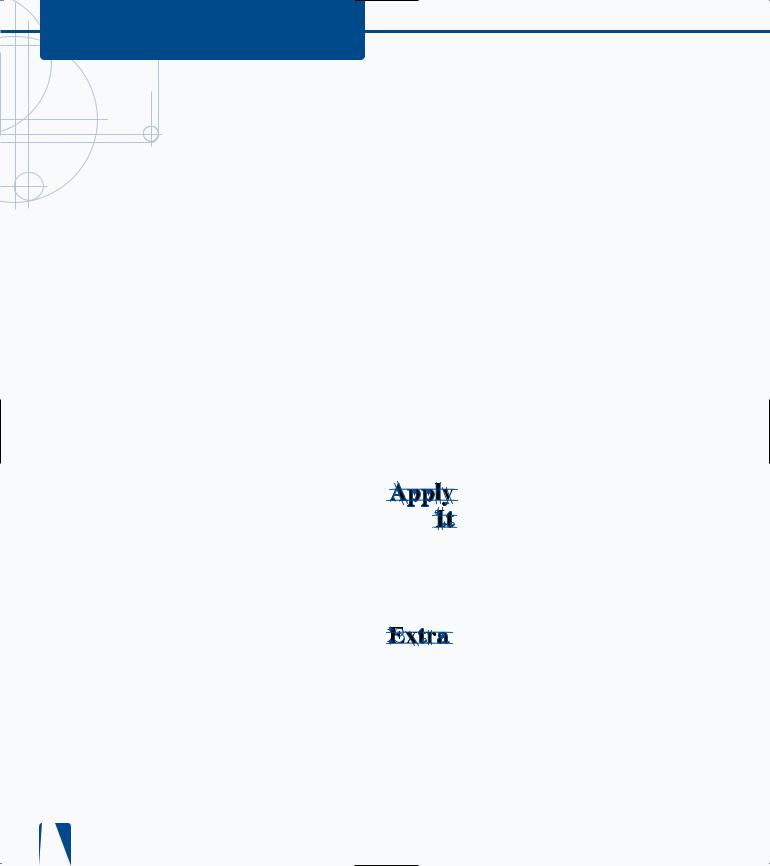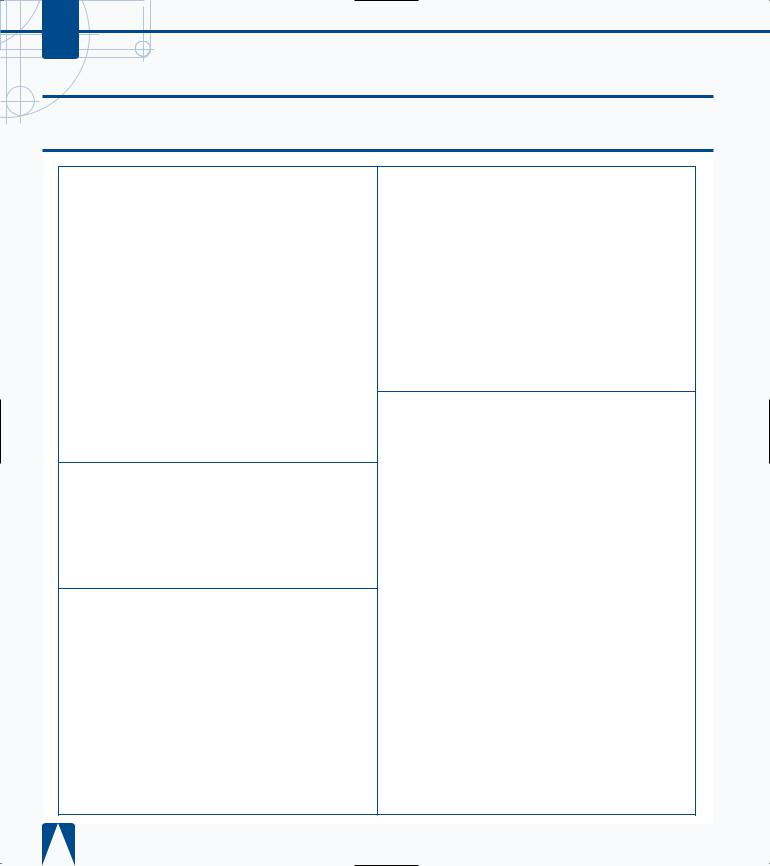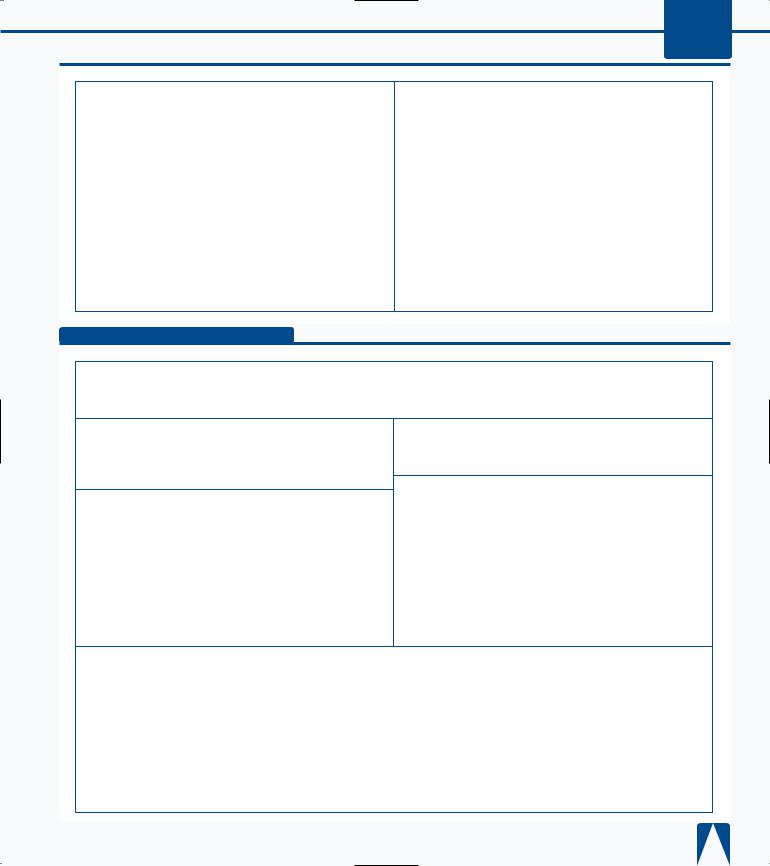
- •maranGraphics
- •CREDITS
- •ACKNOWLEDGMENTS
- •ABOUT THE AUTHORS
- •AUTHORS’ ACKNOWLEDGMENTS
- •TABLE OF CONTENTS
- •HOW TO USE THIS BOOK
- •INTRODUCTION TO C#
- •START VISUAL STUDIO .NET
- •OPEN A NEW C# PROJECT
- •OPEN A C# WEB PROJECT
- •SET JSCRIPT .NET AS THE DEFAULT SCRIPT LANGUAGE
- •EXPLORE THE CLASS VIEW WINDOW
- •VIEW THE CONTENTS WINDOW
- •GET HELP USING THE INDEX WINDOW
- •SEARCH FOR HELP
- •ADD COMPONENTS FROM THE TOOLBOX
- •ADD A TASK TO THE TASK LIST
- •CHANGE FORM PROPERTIES IN THE PROPERTIES WINDOW
- •ADD A CUSTOM TOOLBAR
- •DELETE A TOOLBAR
- •CHANGE THE VISUAL STUDIO ENVIRONMENT
- •MANAGE OPEN WINDOWS
- •OPEN A PROJECT
- •VIEW THE MAIN METHOD
- •COMBINE PROGRAM TYPES
- •ADD REFERENCE TYPES
- •ADD OPERATORS
- •INSERT ATTRIBUTES
- •ENTER CLASSES
- •ADD COMMENTS TO CODE
- •WRITE YOUR FIRST PROGRAM
- •ENTER XML DOCUMENTATION
- •ACCESS DOCUMENTATION
- •LOG A BUG REPORT
- •VIEW INFORMATION ABOUT C# BUILDING BLOCKS
- •PROGRAM CLASSES
- •ADD A CLASS
- •EMPLOY CLASS INHERITANCE
- •PROGRAM INSTANCE CONSTRUCTORS
- •INSERT DESTRUCTORS
- •PROGRAM STRUCTS
- •DISPLAY HEAP AND STACK INFORMATION
- •FIND TYPE INFORMATION
- •PROGRAM CONSTANT EXPRESSIONS
- •SPECIFY VALUE TYPES
- •PROGRAM NUMERIC TYPES
- •PROGRAM THE BOOLEAN TYPE
- •DECLARE REFERENCE TYPES
- •ENTER REFERENCE TYPE DECLARATIONS
- •CONVERT VALUE TYPES TO REFERENCE TYPES
- •PROGRAM POINTER TYPES
- •INSERT THE VOID TYPE
- •ADD INTERFACE PROPERTIES
- •ADD AN INTERFACE INDEX
- •VIEW INFORMATION ABOUT METHODS
- •ADD A METHOD
- •ADD STATIC METHODS
- •INCLUDE NON-STATIC METHODS
- •ENTER DELEGATES
- •PROGRAM EVENTS
- •ADD AN EVENT-HANDLING METHOD
- •VIEW INFORMATION ABOUT ARRAYS
- •ENTER SINGLE-DIMENSIONAL ARRAYS
- •ADD MULTIDIMENSIONAL ARRAYS
- •PROGRAM ARRAY-OF-ARRAYS
- •ITERATE THROUGH ARRAY ELEMENTS
- •SORT ARRAYS
- •SEARCH ARRAYS
- •IMPLEMENT A COLLECTIONS CLASS
- •PROGRAM STRUCTS
- •ADD AN INDEXER
- •INCLUDE ENUMERATIONS
- •CREATE STRING LITERALS AND VARIABLES
- •ASSIGN VALUES TO STRINGS
- •CONCATENATE STRINGS
- •COMPARE STRINGS
- •SEARCH FOR SUBSTRINGS
- •REPLACE CHARACTERS
- •EXTRACT SUBSTRINGS
- •CHANGE THE CHARACTER CASE
- •TRIM SPACES
- •REMOVE CHARACTERS
- •SPLIT A STRING
- •JOIN STRINGS
- •PAD STRINGS
- •VIEW INFORMATION ABOUT PROPERTIES
- •COMPARE PROPERTIES AND INDEXERS
- •PROGRAM PROPERTY ACCESSORS
- •DECLARE ABSTRACT PROPERTIES
- •INCLUDE PROPERTIES ON INTERFACES
- •VIEW INFORMATION ABOUT WINDOWS FORMS
- •ADD A WINDOWS FORM IN THE WINDOWS FORM DESIGNER
- •SET THE FORM TYPE
- •CHOOSE THE STARTUP WINDOWS FORM
- •CREATE A MODAL FORM
- •LAYOUT A FORM
- •SET A FORM LOCATION
- •CHANGE FORM PROPERTIES
- •CREATE A TRANSPARENT FORM
- •AN INTRODUCTION TO WEB FORMS AND CONTROLS
- •CREATE AN ASP.NET WEB SITE
- •CREATE A WEB FORM
- •ADD SERVER CONTROLS TO A WEB FORM
- •READ AND CHANGE PROPERTIES FROM OBJECTS ON A WEB FORM
- •USING SERVER-SIDE COMPONENTS ON WEB FORMS
- •INTRODUCING DATA ACCESS WITH ADO.NET
- •DISPLAY DATA WITH THE DATAGRID CONTROL
- •CONFIGURE THE DATAGRID CONTROL
- •INSERT DATA INTO A SQL DATABASE
- •UPDATE DATA FROM A SQL DATABASE
- •DELETE DATA FROM A SQL DATABASE
- •EXECUTE A STORED PROCEDURE IN A SQL DATABASE
- •READ XML FROM A FILE
- •SAVE XML TO A FILE
- •QUERY XML WITH XPATH
- •APPLY XSL TO XML
- •INTRODUCTION TO DISTRIBUTED APPLICATIONS
- •CREATE AN APPLICATION WITH PRIVATE ASSEMBLIES
- •CREATE AN APPLICATION WITH SHARED ASSEMBLIES
- •VERSION A SHARED ASSEMBLY
- •CONFIGURE A CLIENT FOR A VERSIONED ASSEMBLY
- •CREATE A WEB SERVICE
- •USING A WEB SERVICE
- •INTRODUCTION TO EXCEPTION HANDLING
- •THROWING AN EXCEPTION
- •HANDLING EXCEPTIONS WITH THE CATCH BLOCK
- •USING THE FINALLY BLOCK
- •WRITE ERRORS TO THE APPLICATION LOG
- •BASIC EXAMPLES
- •WHAT’S ON THE CD-ROM
- •USING THE E-VERSION OF THIS BOOK
- •INDEX
- •Symbols & Numbers

HOW TO USE THIS BOOK
C#: Your visual blueprint for building .NET applications uses simple, straightforward examples to teach you how to create powerful and dynamic programs.
To get the most out of this book, you should read each chapter in order, from beginning to end. Each chapter introduces new ideas and builds on the knowledge learned in previous chapters. Once you become familiar with C#: Your visual blueprint for building .NET applications, this book can be used as an informative desktop reference.
Who This Book Is For
If you are interested in writing programs for the new Microsoft C# programming language, then C#: Your visual blueprint for building .NET applications is the book for you.
This book will take you through the basics of using the Visual Studio Microsoft Development Environment (MDE) window and familiarize you with the essentials of C# programming. The book even covers advanced topics including creating forms, macros, and Web applications.
No prior experience with programming is required, but familiarity with the Microsoft Windows operating system installed on your computer is an asset.
WhatYou Need To Use This Book
To perform the tasks in this book, you need a computer with Microsoft Windows NT 4.0 or 2000 installed as well as Microsoft Visual Studio.NET. You do not require any special development tools since all the tools are contained within Visual Studio .NET. However, you do need a Web browser such as Microsoft Internet Explorer.
The Conventions In This Book
A number of typographic and layout styles have been used throughout C#: Your visual blueprint for building
.NET applications to distinguish different types of information.
Courier Font
Indicates the use of C# code such as tags or attributes, scripting language code such as statements, operators or functions and ASP code such as objects, methods or properties.
Bold
Indicates information that must be typed by you.
Italics
Indicates a new term being introduced.
An Apply It section usually contains a segment of code that takes the lesson you just learned one step further. Apply It sections offer inside information and pointers that can be used to enhance the functionality of your code.
An Extra section provides additional information about the task you just accomplished. Extra sections often contain interesting tips and useful tricks to make working with C# easier and more efficient.
xiv

The Organization Of This Book
C#: Your visual blueprint for building .NET applications contains 15 chapters and two appendixes.
The first chapter, Getting Started with C#, introduces you to C#, how to start Visual Studio .NET and open a new C# project, how to learn about C# online and how you can run C# with Web pages and Java.
Chapter 2, Exploring the C# Interface, shows you how to navigate and work with the Visual Studio .NET MDE window and receive online help. This chapter helps you use the power of the MDE window to your greatest advantage when you create C# programs.
Chapter 3, Working wiht Visual C# Basics, introduces you to the essentials of C#. This chapter also covers some C# programming fundamentals that enable you to use the material in the following chapters to create your own C# programs.
The fourth chapter, Programming C# Building Blocks, gets you started with programming C# modules and their two main building blocks, classes and structures.
Chapters 5 through 9 explore how you can add different C# elements to your program — types and interfaces, methods and events, arrays, strings, and properties. You are shown in detail how to access and utilize each of these fundamental elements of C#.
Chapter 10, Building Forms, shows you how to build forms in C# so users can interact with your program.
Chapter 11, Programming Web Applications, shows you how you can integrate forms, buttons, controls, and other Web features into your program for distribution and use on the Web.
Chapter 12, Accessing DATA with C# and ADO.NET, shows you how you can design C# and XML components and create and run C# macros.
C#:
Your visual blueprint for building .NET applications
Chapter 13, Using the XML Framework Class, shows you how to distribute your program on one computer, on the network, and on the Web. You will also learn how to manage program changes and distribute those changes.
Chapter 14, Creating and Deploying Distributed Applications, shows you how to check the performance of your program, manage the debugger
Chapter 15, Working with Errors, shows you how to review common C# errors that you should avoid.
The first appendix contains a reference section. Once you are familiar with the contents of this book, you can use the C# references to obtain at-a-glance information for some of the most commonly used C# statements.
What Is On The CD-ROM
The CD-ROM disc included in this book contains the sample code from each of the two-page lessons. This saves you from having to type the code and helps you quickly get started creating C# code. The CD-ROM disc also contains several shareware and evaluation versions of programs that can be used to work with
C#: Your visual blueprint for building .NET applications. An e-version of the book is also available on the disc.
xv

C#
INTRODUCTION TO C#
C# is a new programming language created by Microsoft and introduced with the release of Visual Studio .NET (also known as Visual Studio .NET 7.0).
C# lets you write programs that enable you to manipulate the computer to perform certain tasks.
The Birth of C#
As a recent birth in the programming language family, C# has two programming language parents: C++ and Java. C# contains many C++ features but also adds the object-oriented features from Java.
C# contains many different components, including:
•Versioning support, so that your base and derived classes — templates that define how an object performs — remain compatible as you develop them
•Events, so that your program can notify clients of a class about something that has happened to an object
•Type safety and verification that increases reliability and ensures code security
•Garbage collection, so that your program can identify objects that your program can no longer reach
•Unsafe mode, where you can use pointers to manipulate memory outside the garbage collector’s control, including methods and properties
Close Relations with C and C++
C# is built on the C++ language, so it behaves much like the language. Like C++, C# lets you write enterprise applications, and C# contains many C++ features, including statements and operators. C# also provides access to common Application Program Interface (API) styles including Component Object Model (COM) and C-style APIs.
Security
Computer networks let programmers share Visual Studio .NET code including C# programs across the network. This collaborative effort lets you and your programming team create C# programs much more quickly than one person alone. The problem with collaborating over a network is that unauthorized users from within or outside your network may try to gain access to your C# program code.
Visual Studio .NET provides built-in security features so you or the leader of your programming team can determine who on your network gets access to your C# program code and resources. You can also set different levels of security for different people in case you want only certain people to have access to certain program code.
Integration
The primary advantage of using Visual Studio .NET is that all of the programming languages have been designed to work together from the start. When you write a new C# program, Visual Studio .NET gives you tools that you can use to program links from your C# program into another program written in another Visual Studio .NET language.
For example, you can create a database in Visual FoxPro and then create a C# program that links into the Visual FoxPro database. If you have written or acquired completed programs in a Visual Studio language such as Visual C++ or Visual Basic, you can include links from your C# program into those programs. The end result is seamless integrated functionality between programs.
Differences Between C# and C++
Microsoft includes Visual C++ and C# in Visual Studio
.NET. On the surface, C# has few differences from Visual C++. When you look carefully and start programming, you will notice that C# differs in several important respects from Visual C++:
•C# has an alternate method of accessing the C++ initialization list when constructing the base class.
•A class can inherit implementation from only one base class.
•You can call overridden base class members from derived classes.
•C# has a different syntax for declaring C# arrays.
•There are differences in several different types including bool, struct, and delegate.
•The Main method is declared differently.
•Support of the new ref and out method parameters that are used instead of pointers for passing parameters by reference.
•New keywords including extern and static.
•New statements including switch and finally.
•New operators including is and typeof.
•Different functionality for some operators and for overloading operators.
2

GETTING STARTED WITH C# |
1 |
DLLs
The advent of Windows brought dynamic link libraries (DLLs) to programmers. DLLs are small, independent programs that contain executable routines that programs can use to produce a certain result in Windows. For example, if a program needs to open a file, you can write your C# program that uses the code in the DLL to open the file. Using DLLs frees up your time to work on your program without having to reprogram the same code in your C# program over and over again.
You can access DLLs from your C# program, and create DLLs in C# for your C# program to refer to when necessary. C# has full COM/Platform support, so you can integrate C# code with any programming language that can produce COM DLLs such as Visual C++.
XML
Extensible Markup Language (XML) is a more powerful version of HyperText Markup Language (HTML), the standard Web page language. Visual Studio .NET and C# let you document your program using XML and then extract the XML code into a separate file.
Visual Studio .NET supports XML so that you can integrate your C# programs with the World Wide Web. You can document your C# code using XML and then use XML for creating Web Services and Web controls that let you and your code interact with a Web site. For example, you may have an inventory system written in C# that interacts with the order-taking page on your company’s Web site.
COMPARE C#, VISUAL C++, AND JAVA
Many of the simple programming procedures that you use in C# are similar in both parent languages — Visual C++ and Java — and in some cases the procedures are
identical. The following are examples of simple programming procedures that illustrate the similarities and differences between C#, Visual C++, and Java.
Declaring Variables |
|
|
C#: |
Visual C++: |
Java: |
int x; |
int x; |
int x; |
int x=3; |
int x=3; |
int x=3; |
FOR Loops
C#:
for (int i = 1; i <= 10; i++) Console.WriteLine("The number is {0}", i);
Visual C++:
for (int i = 1; i < 11; i++) printf("%d\n", i);
Java:
for (int i = 1; i < 11; i++) System.out.println("The number is " + i);
Assignments |
|
|
C#: |
Visual C++: |
Java: |
xValue=7; |
xValue=7; |
xValue=7; |
WHILE Loops |
|
|
C#: |
|
|
while (x < 100); x++;
Visual C++:
while (x < 100); x++;
Java:
while (x < 100); x++;
If-Else Statements |
|
|
C#: |
Visual C++: |
Java: |
if (nCount < nMax) |
if (nCount < nMax) { |
if (nCount < nMax) { |
{ |
nTotal += nCount; |
nTotal += nCount; |
nTotal += nCount; |
nCount++; |
nCount++; |
nCount++; |
} |
} |
} |
else { |
else { |
else { |
nTotal += nCount; |
nTotal += nCount; |
nTotal += nCount; |
nCount —; |
nCount —; |
nCount —; |
}; |
} |
} |
|
|
3
